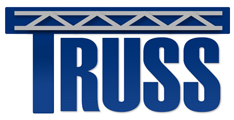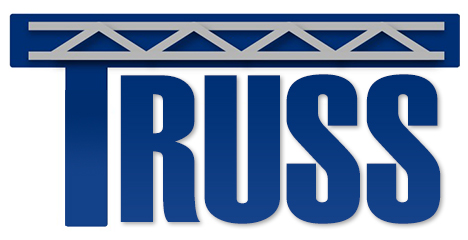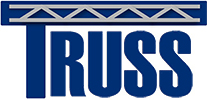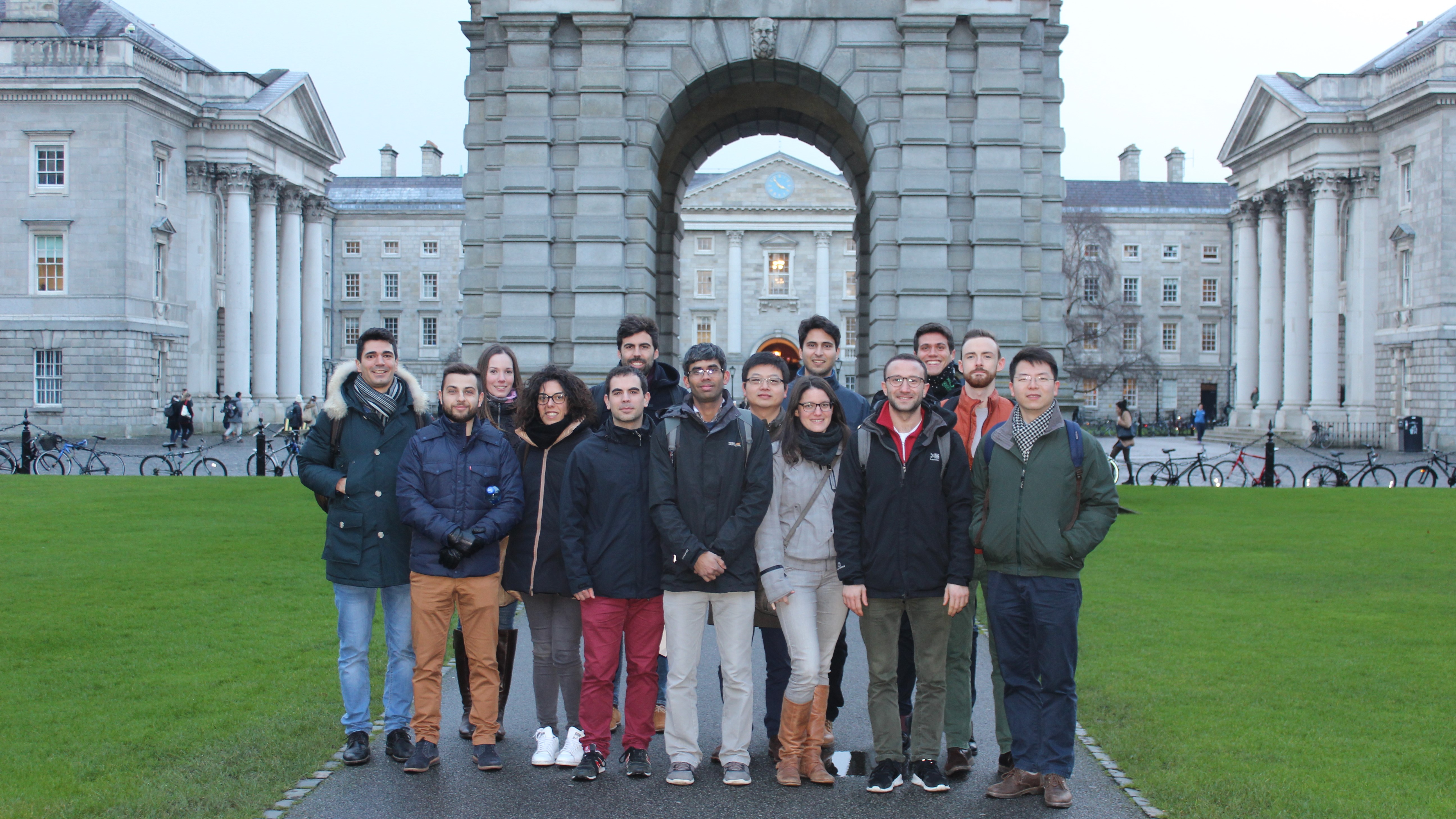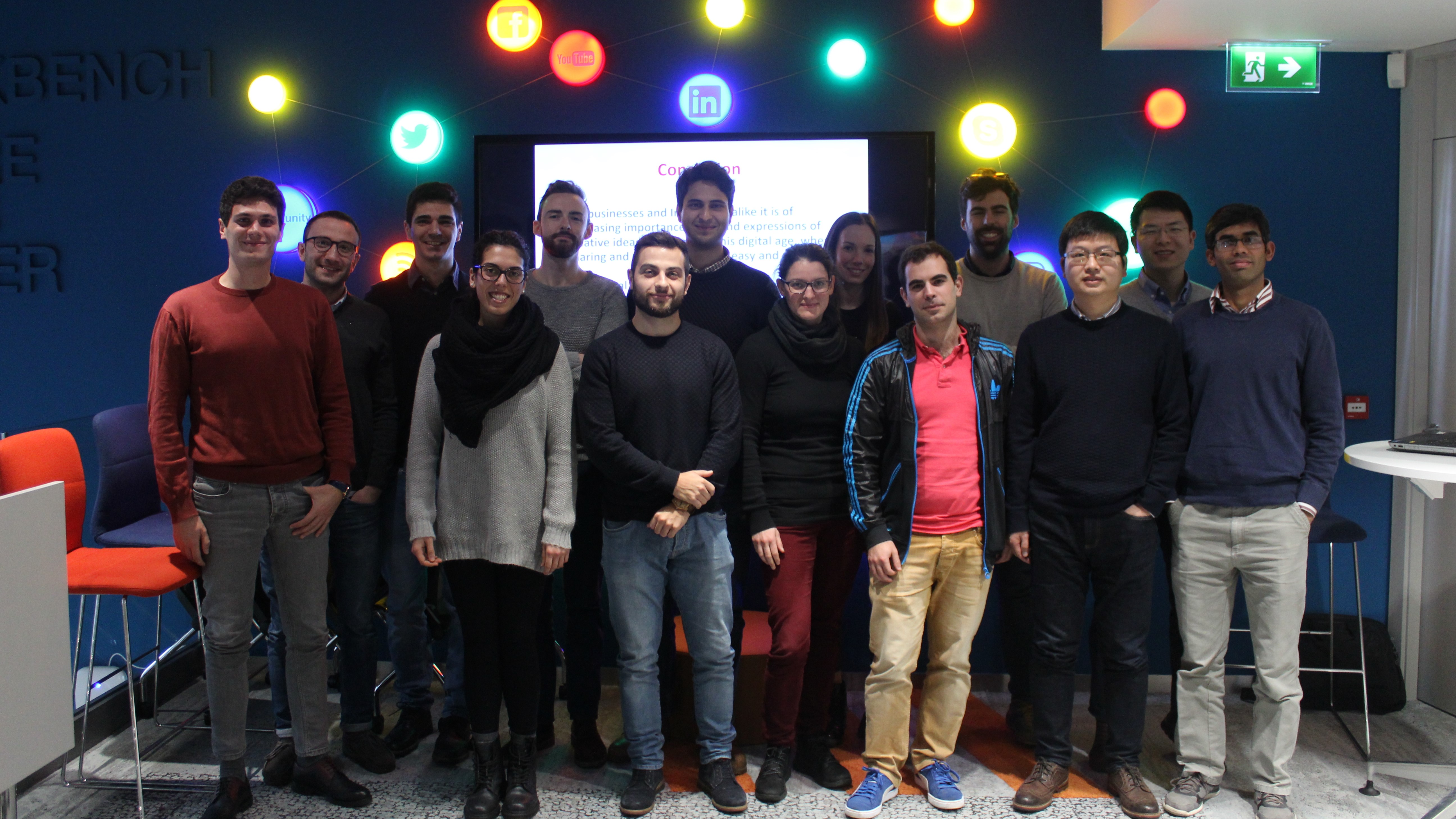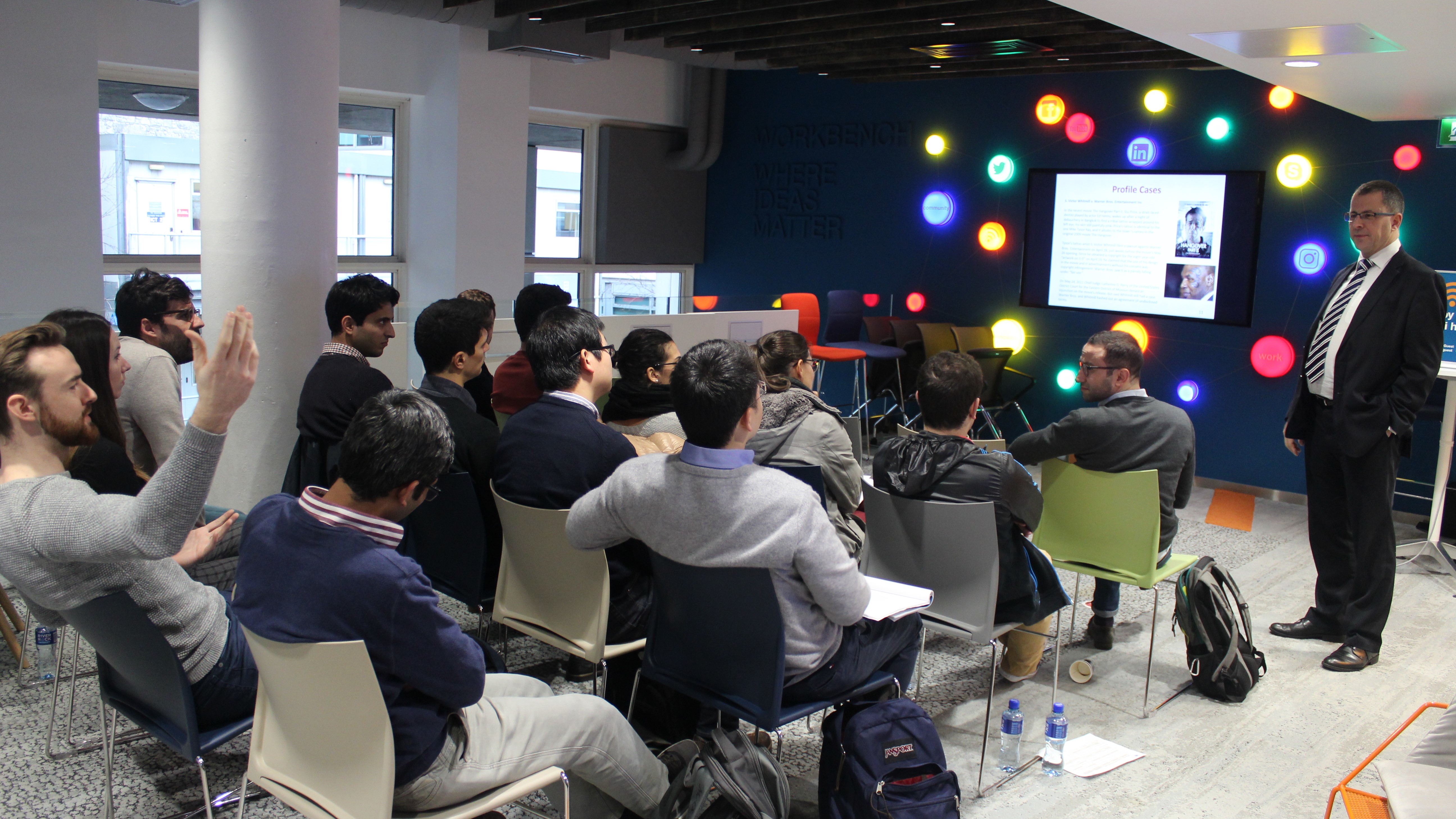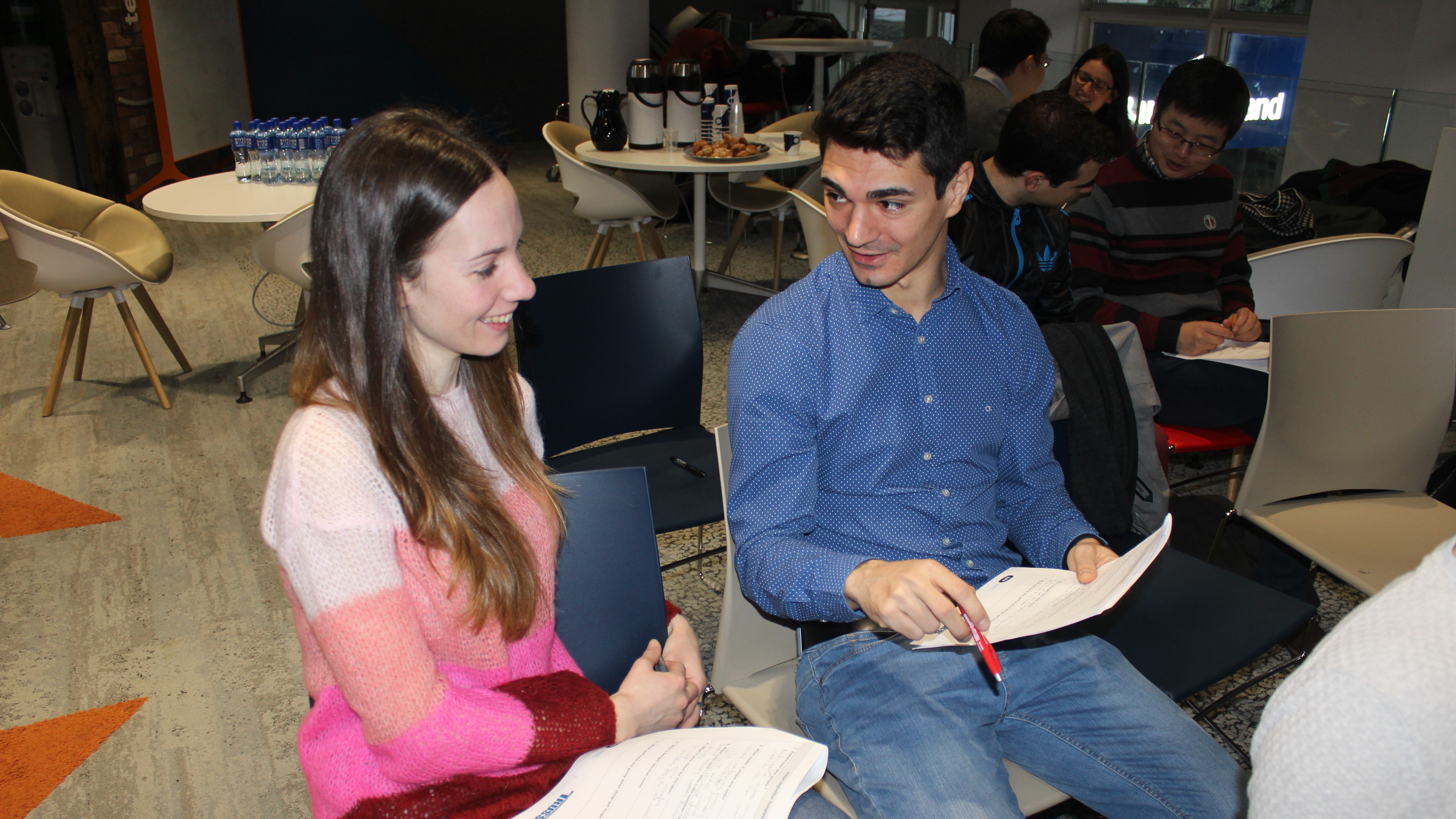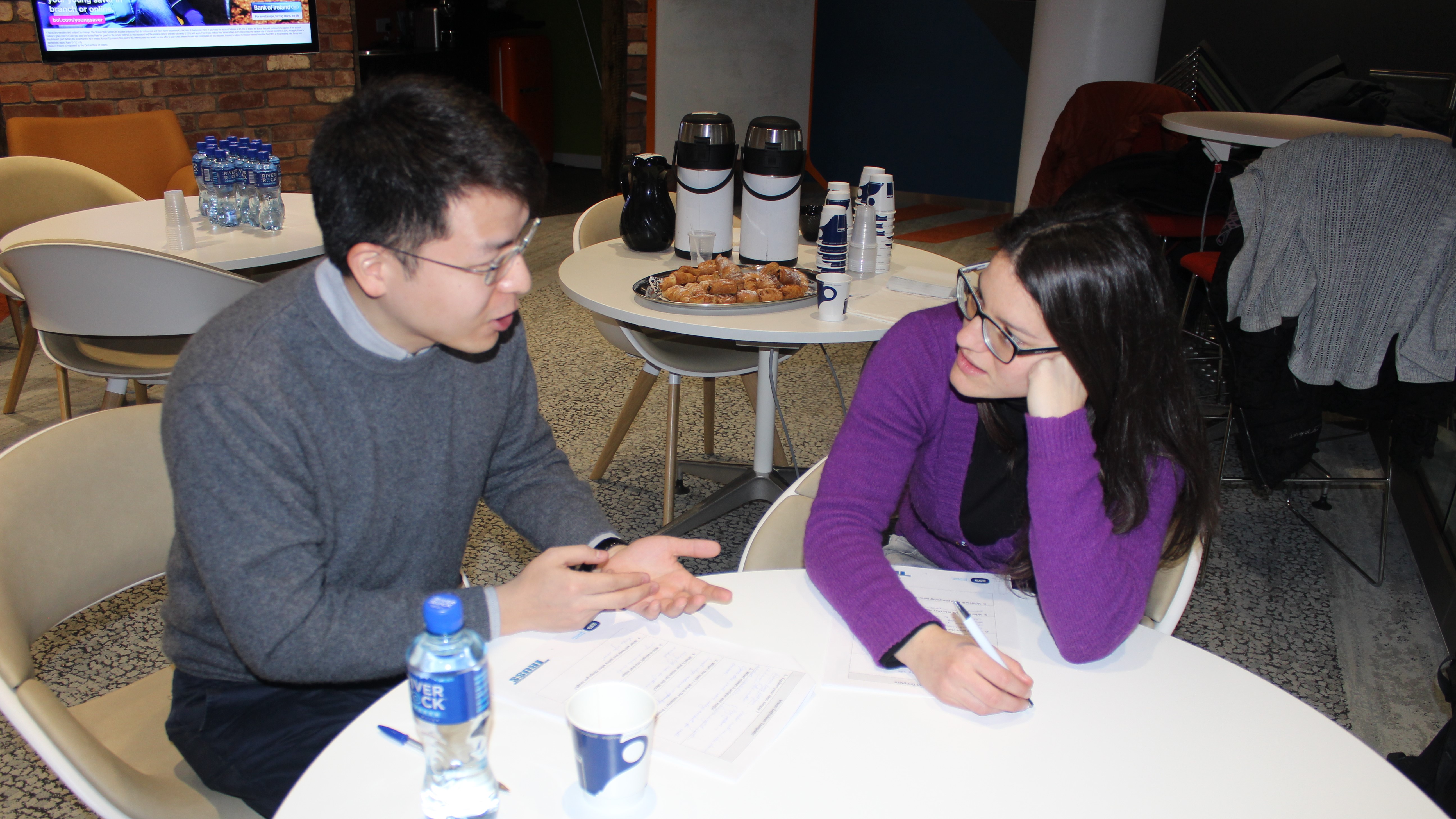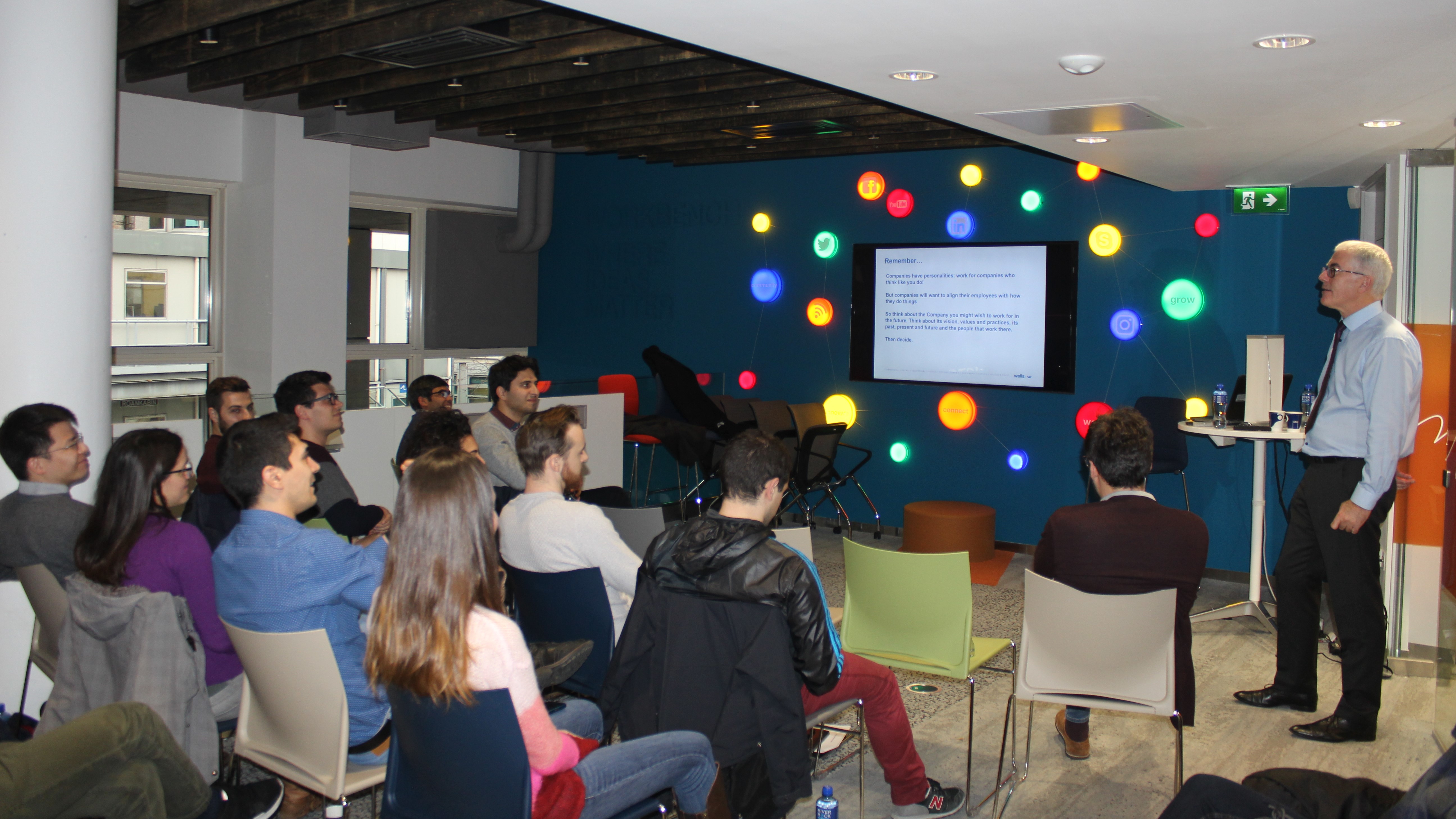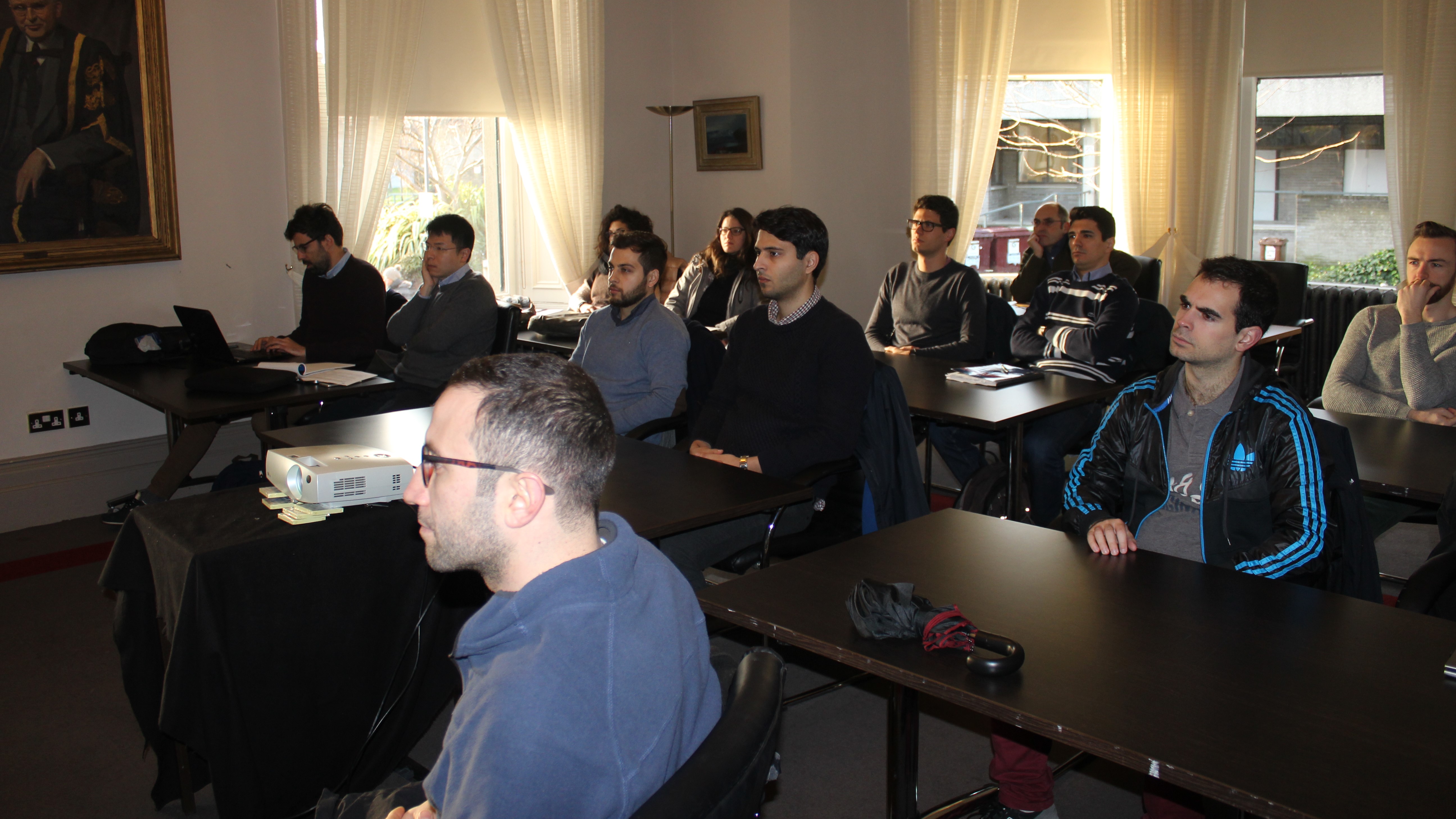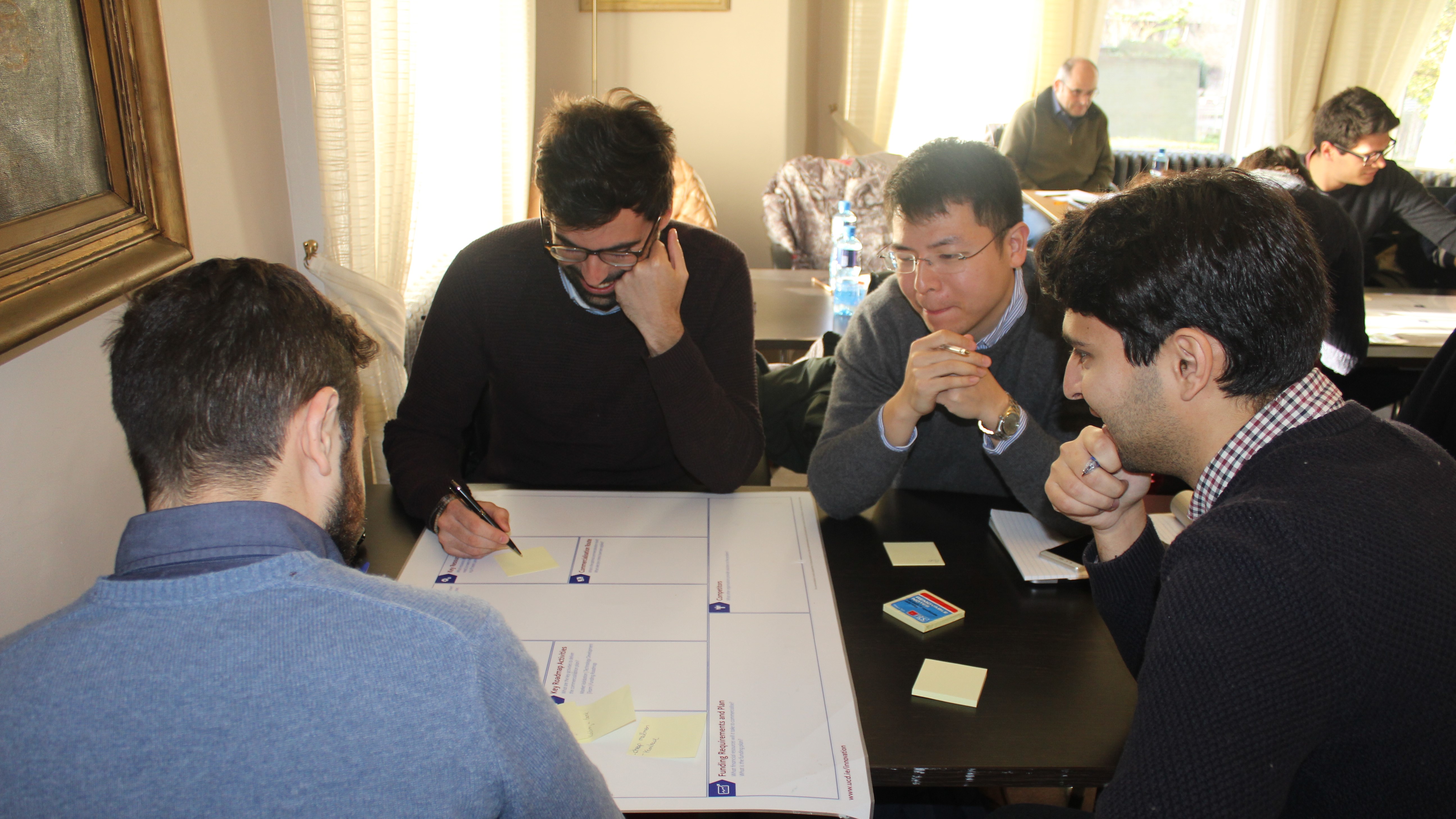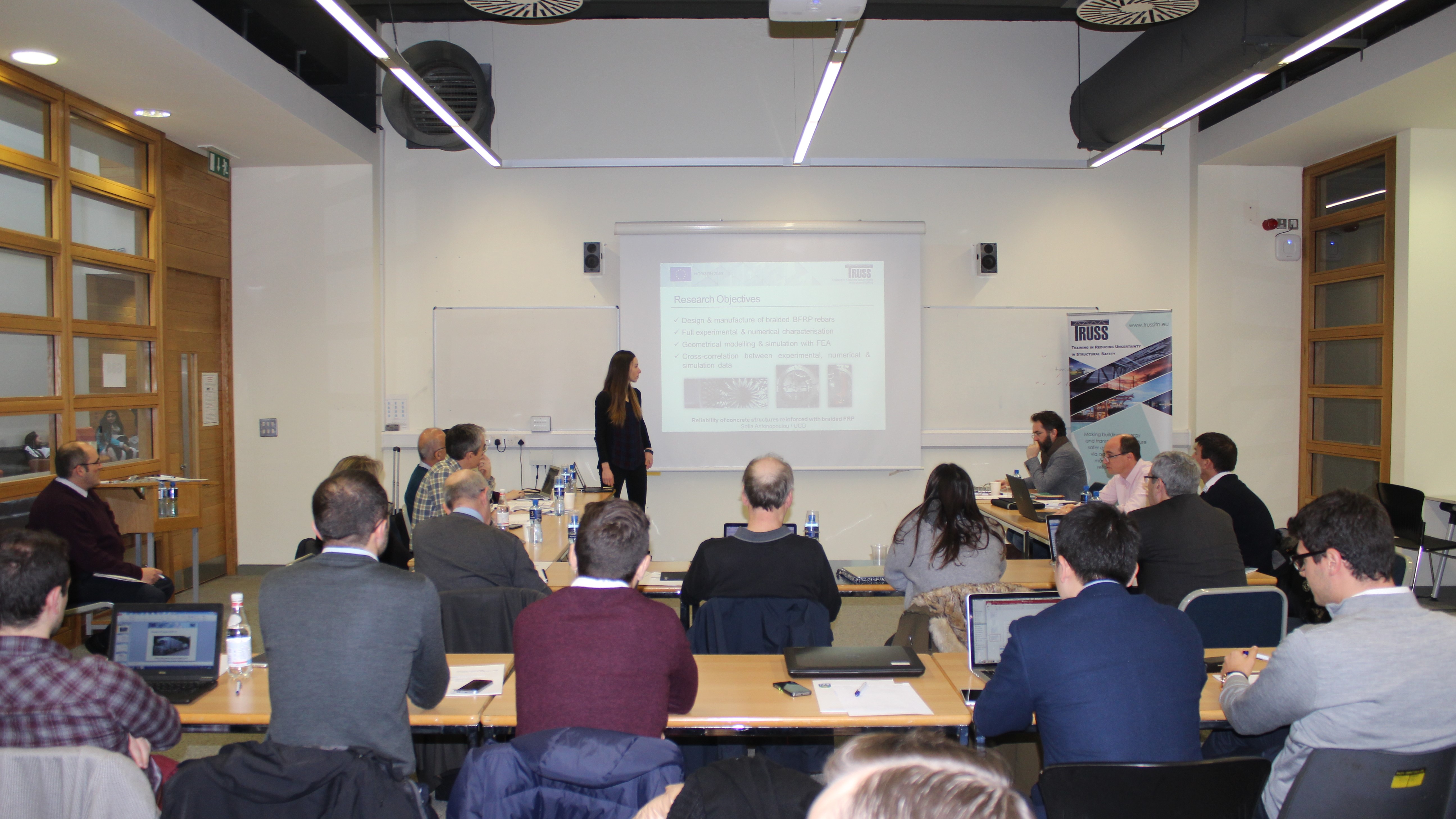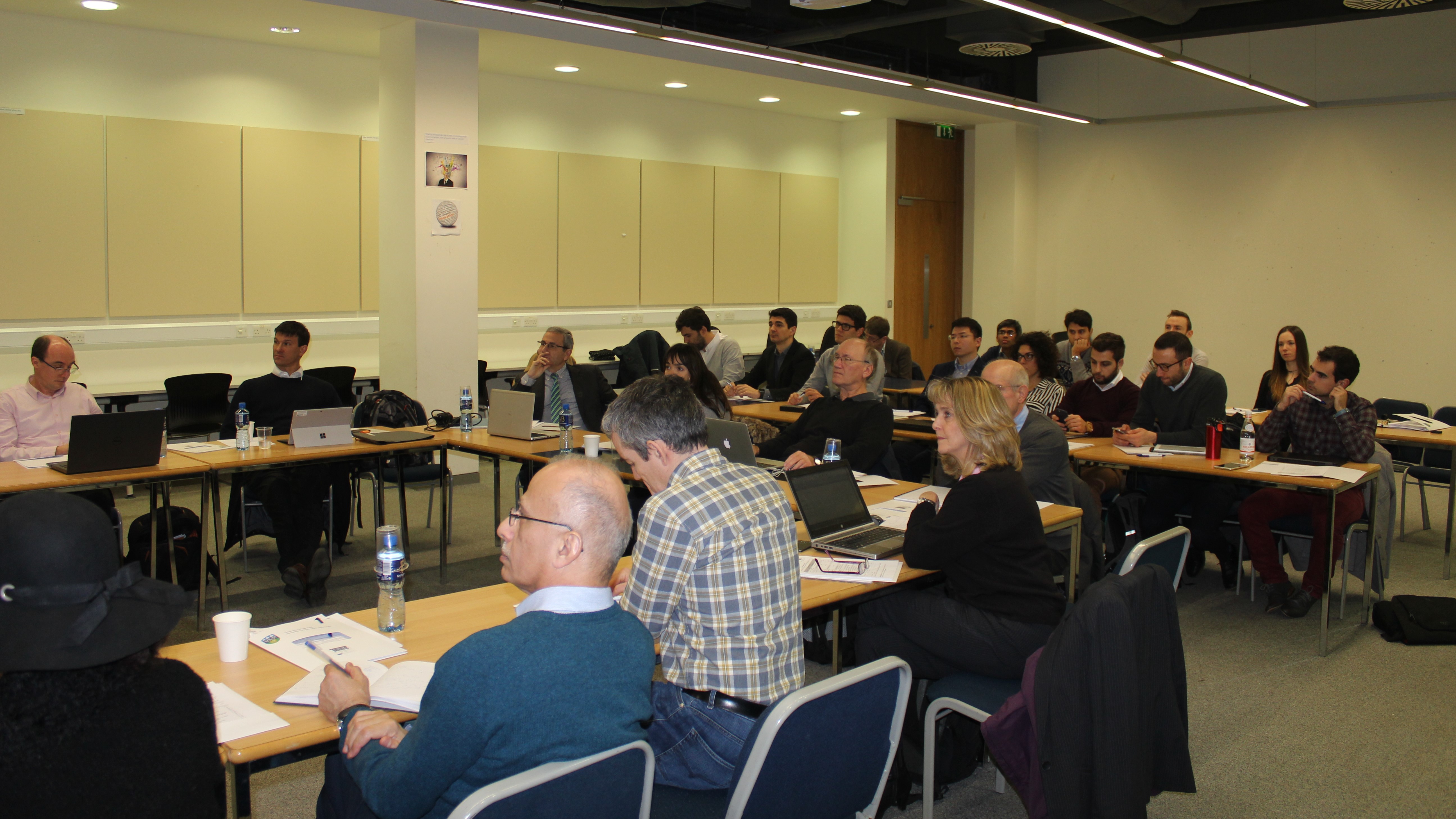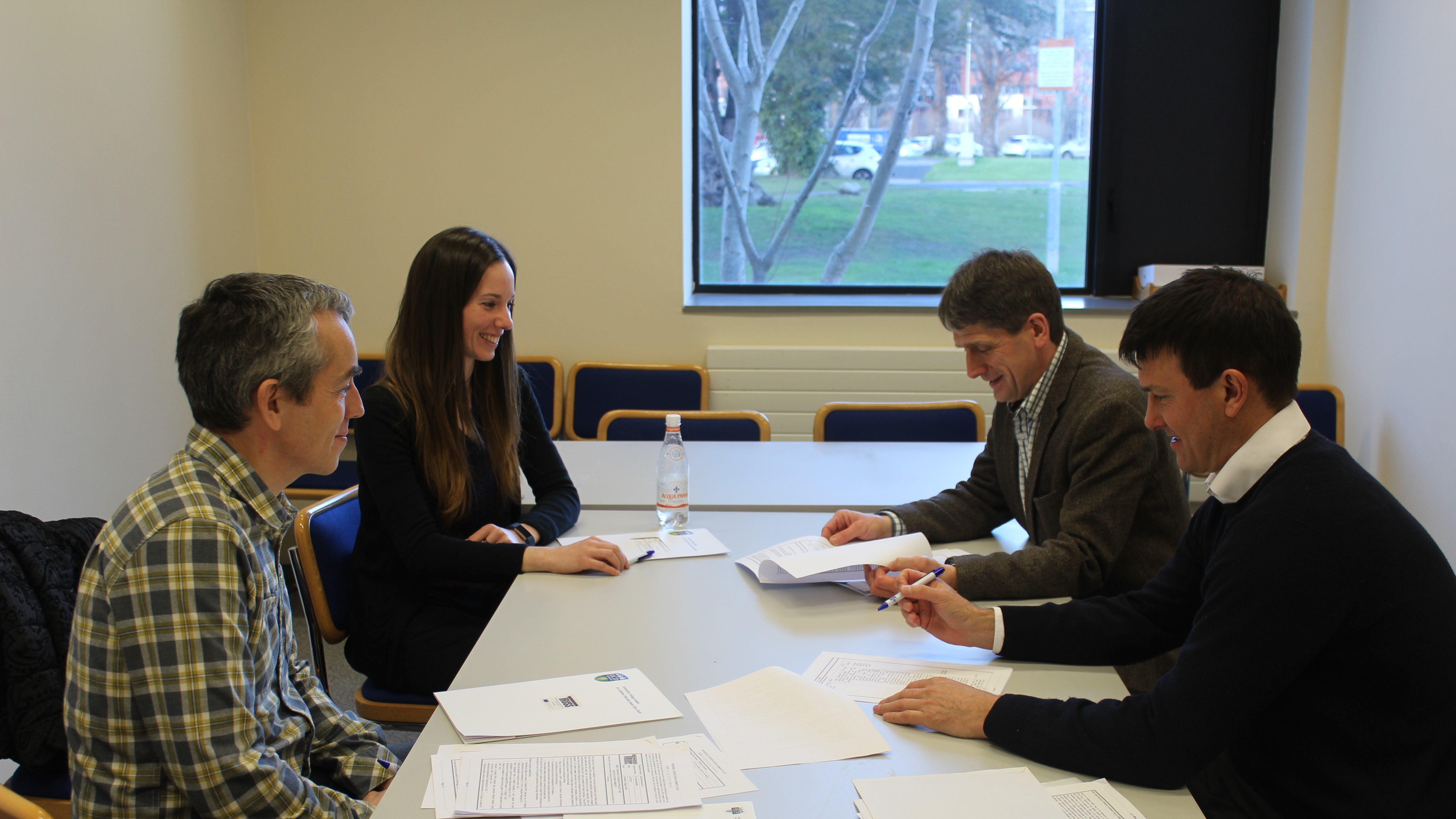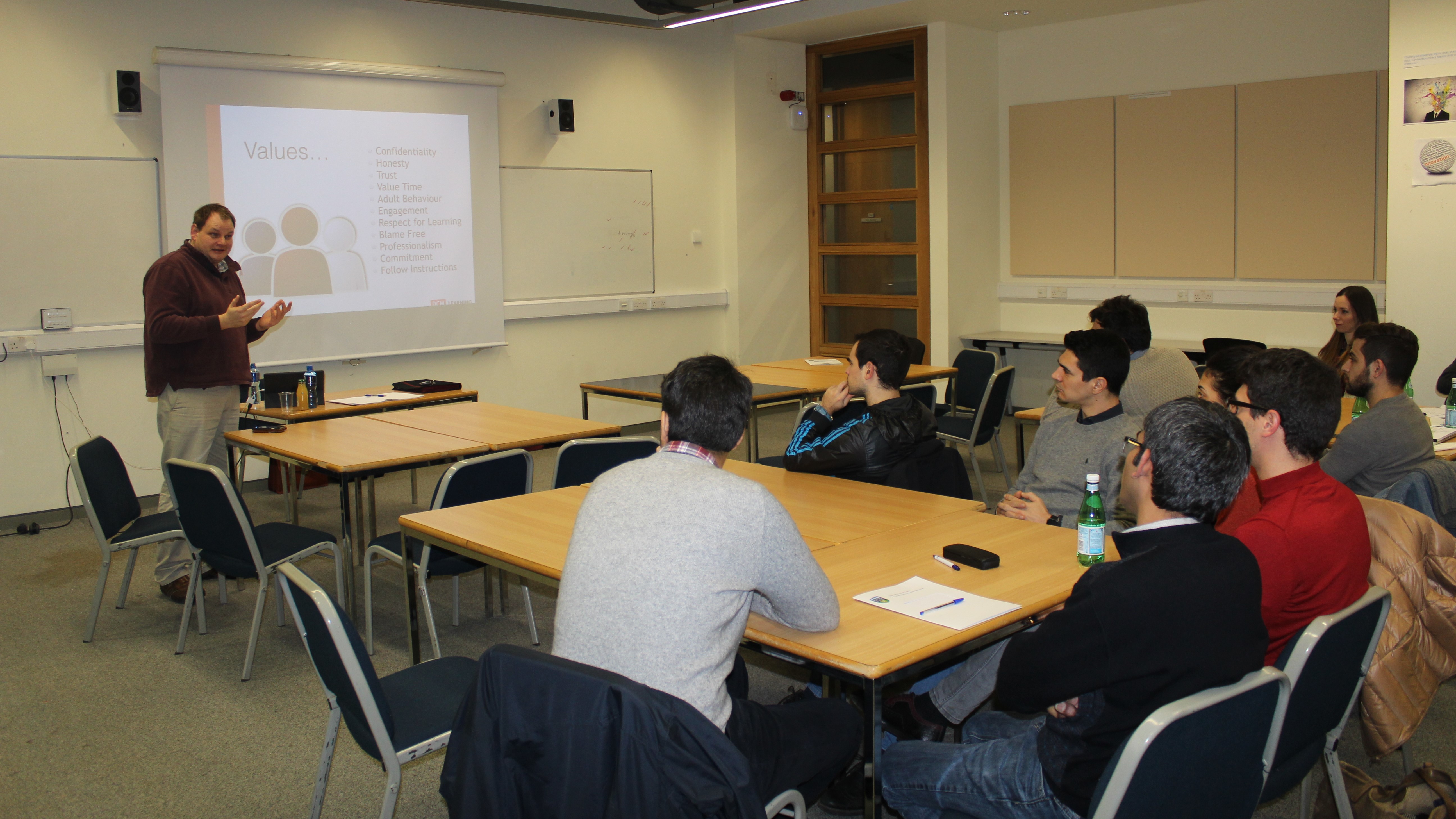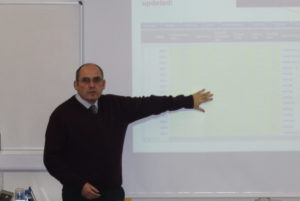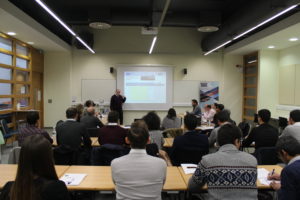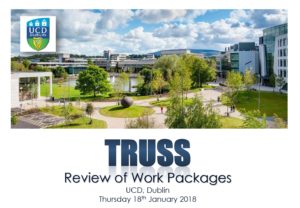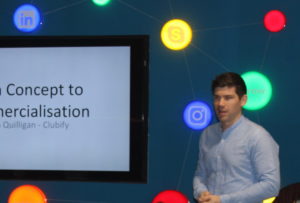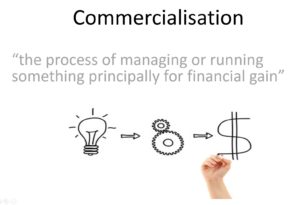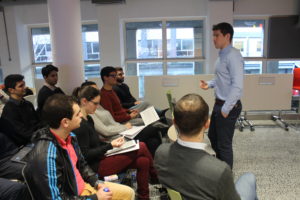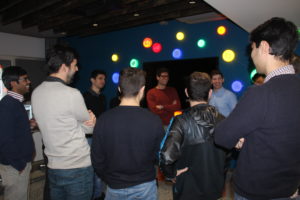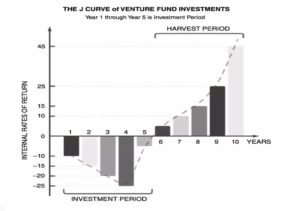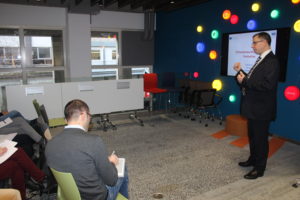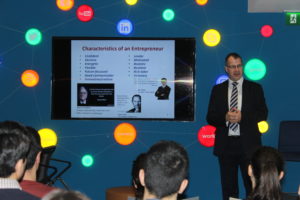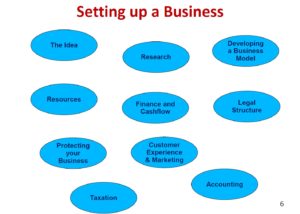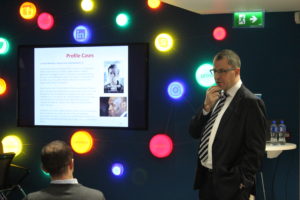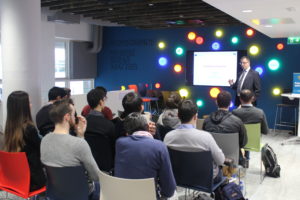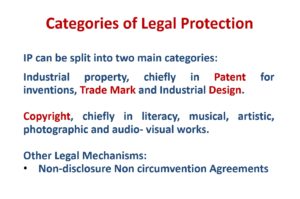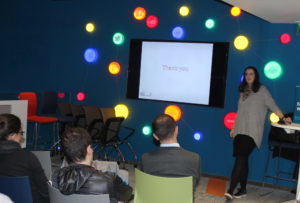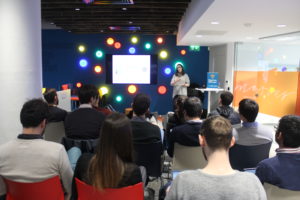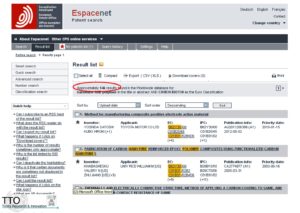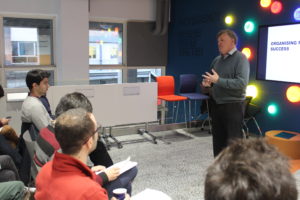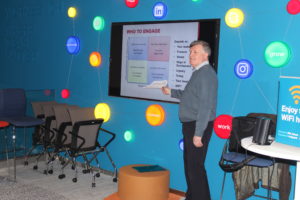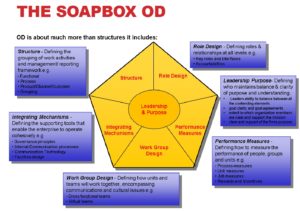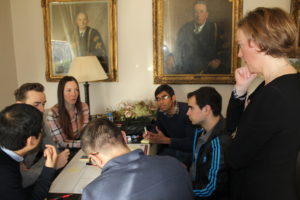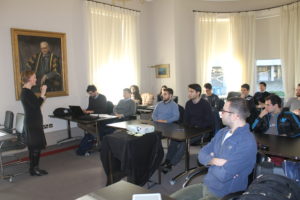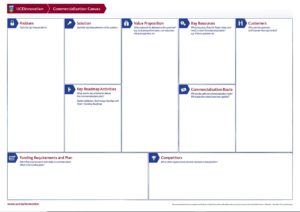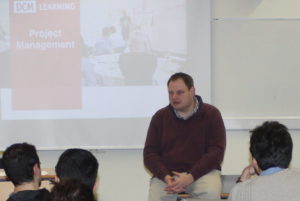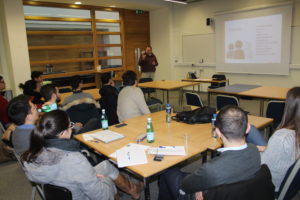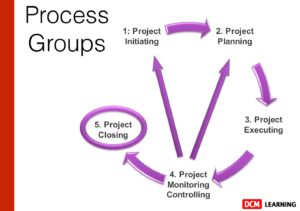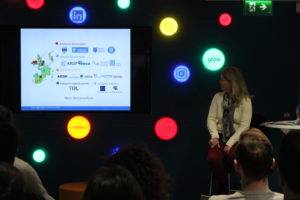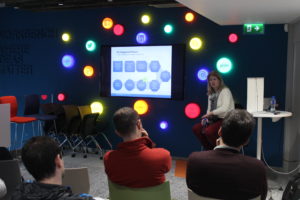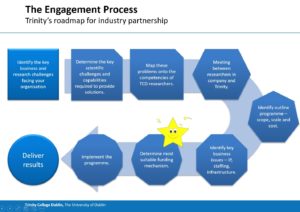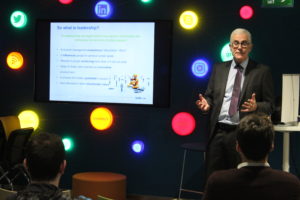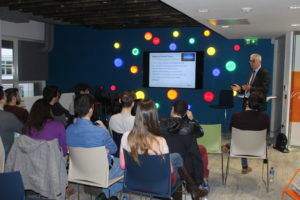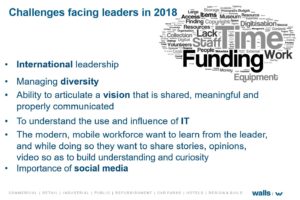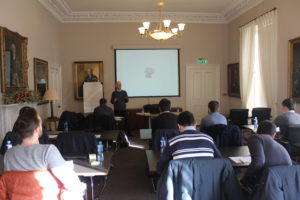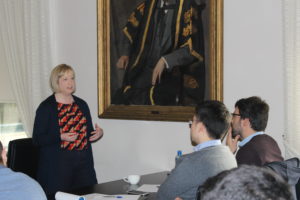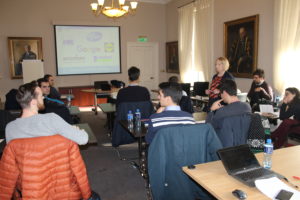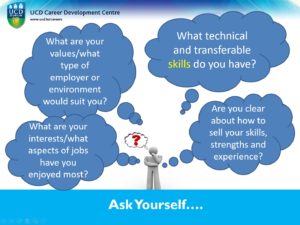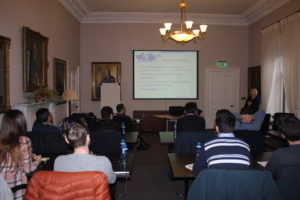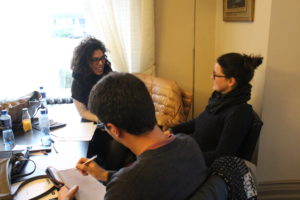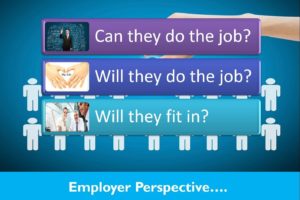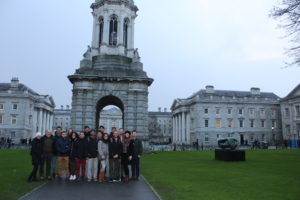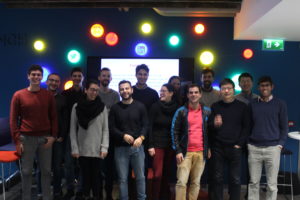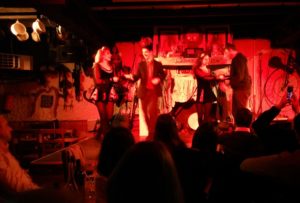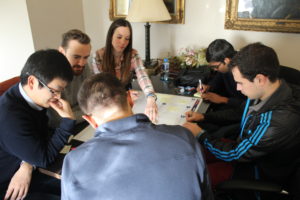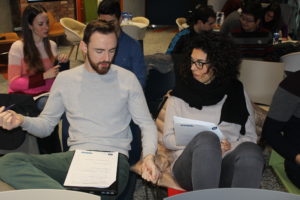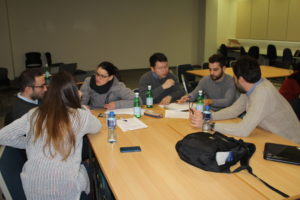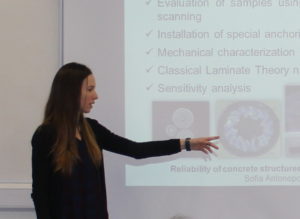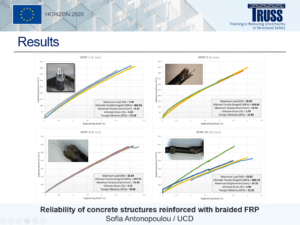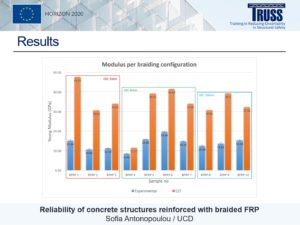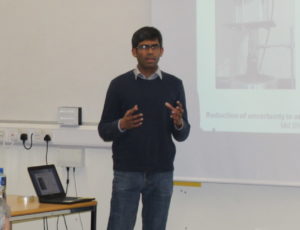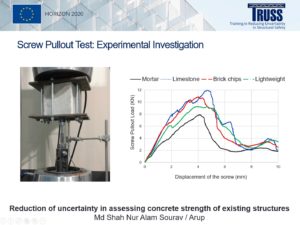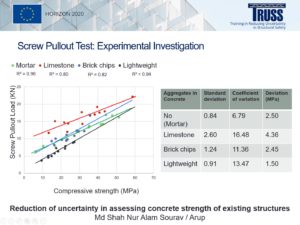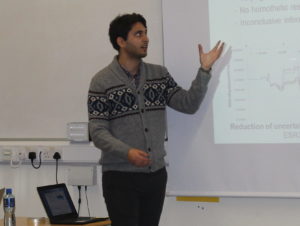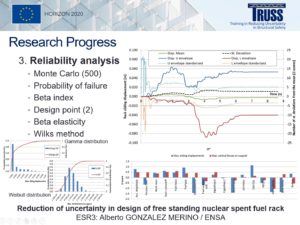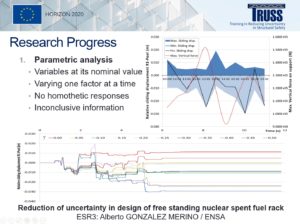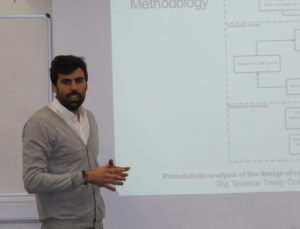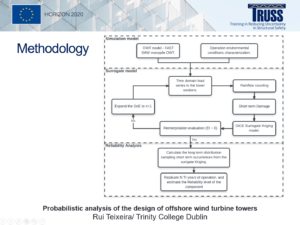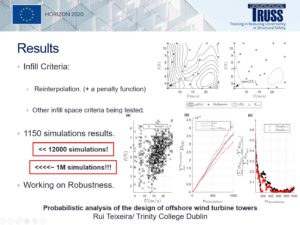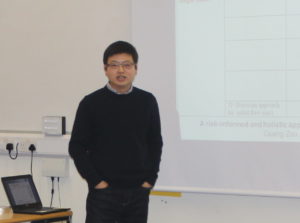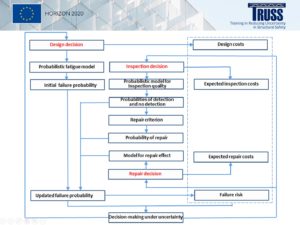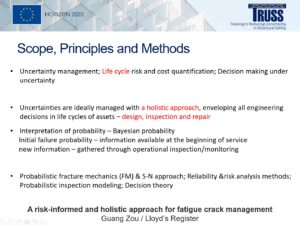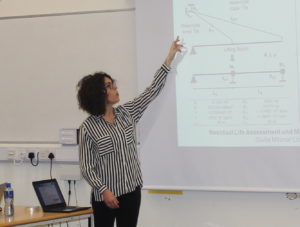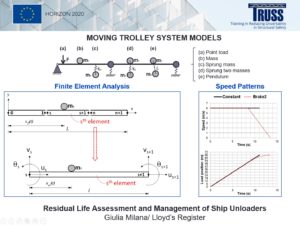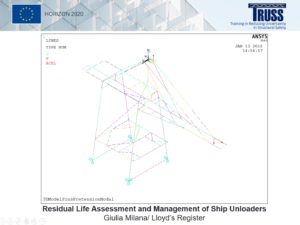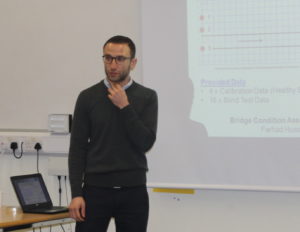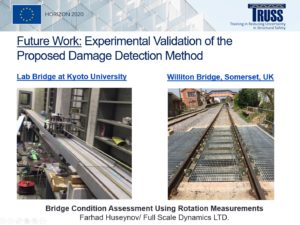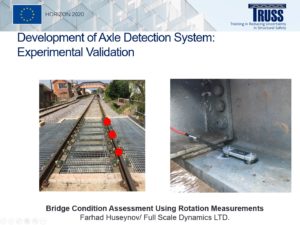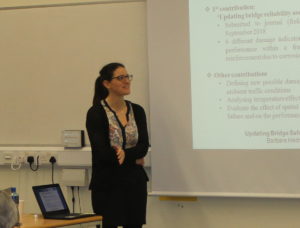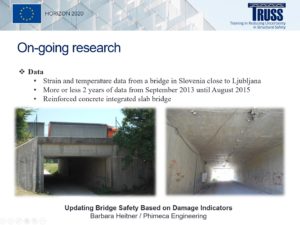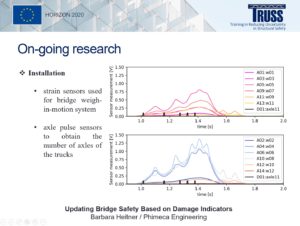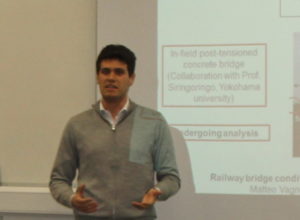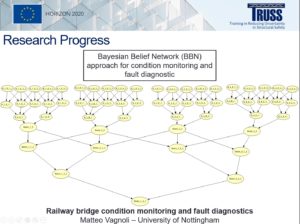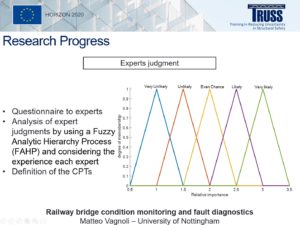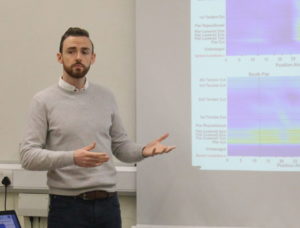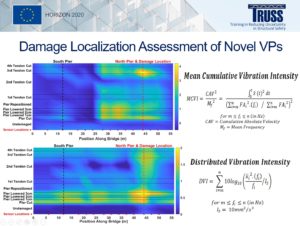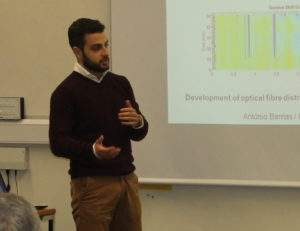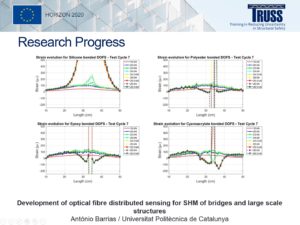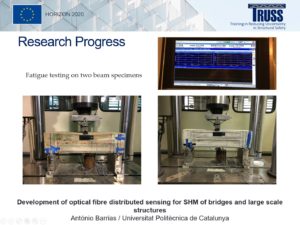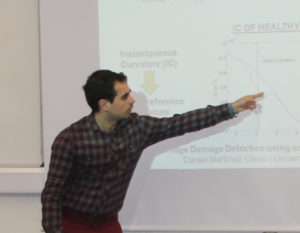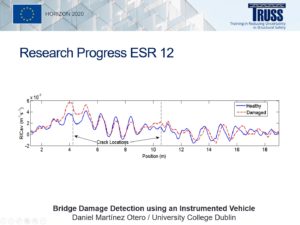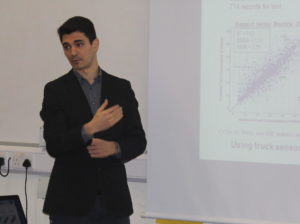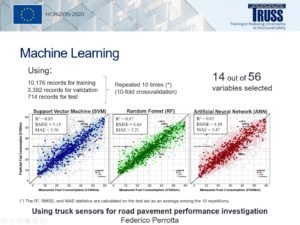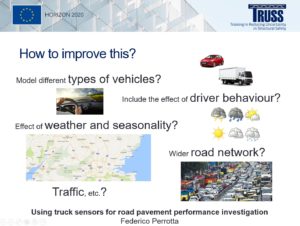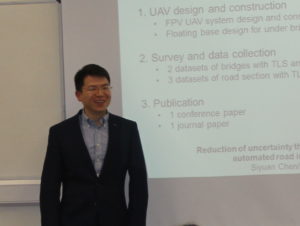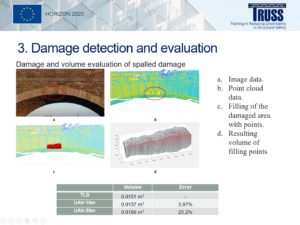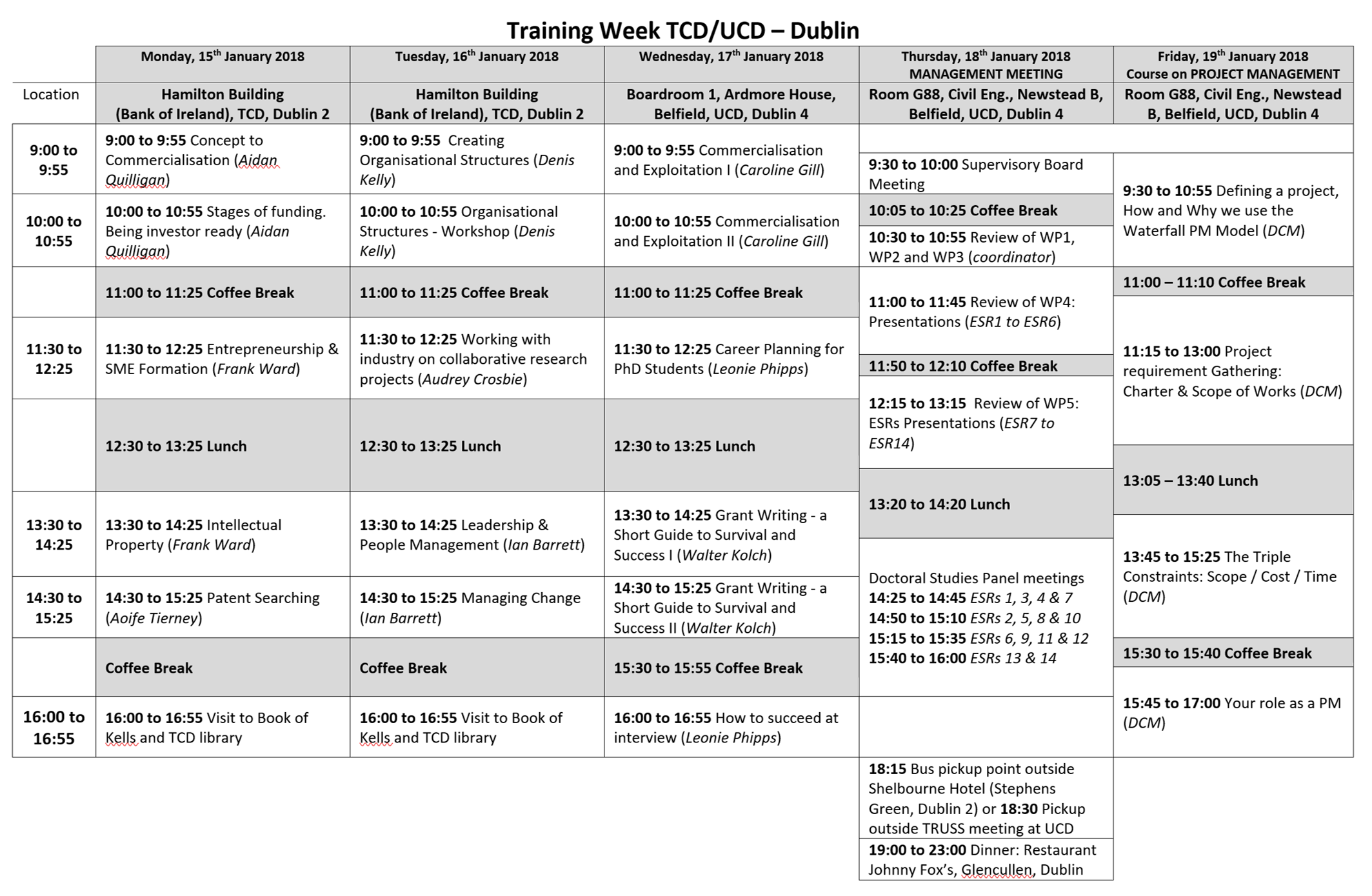TRUSS third training week was held in University College Dublin and Trinity College Dublin from Monday 15th to Friday 19th January 2018. The schedule for the week can be found at the bottom of this page. The questions addressed in each module are described in the expandable toggles below.
To give ESRs an update on the progress of the project and forthcoming activities.
Description
TRUSS achievements and progress in all Work Packages are presented to the ESRs on the morning of Thursday 18th January. ESRs are reminded on the network-wide activities that are left before completion of the project. Two of the most significant activities are a final workshop and a symposium, together with the deliverables that will be due and requiring their input. Emphasis is placed upon the importance of drawing a clear plan into their PCDPs to timely finish their PhDs. Statistics on the impact of social media and website are reported according to the number of visitors, countries, gender, etc. Info is also provided on the number of views of the fellows’ blogs, their most popular tweets/posts, publications, and the training, conferences and outreach activities that have been undertaken within the period from the last meeting in London back in May 2017 to date.
Business Skills Modules
UCD and TCD have imparted training on the entrepreneurial process in the journey from identification of the research innovative idea through to the launch of a successful business. The lectures have defined the stages and processes involved in the creation, capture, management and commercialization of IP. Practical guidelines on how to manage the development and transfer of these intellectual assets to the knowledge economy have been provided. The contents have been grouped under seven main headings: ‘Concept to Commercialisation’, ‘Stages of Funding. Being investor ready’, Entrepreneurship & SME Formation’, ‘Intellectual Property’, ‘Patent Searching’, ‘Creating Organisational Structures’ and ‘Commercialisation and Exploitation’.
Objective
Commercialisation is the process of managing or running a something principally for financial gain. ESRs are shown how to take ideas and bring them to the market. Concepts from PhD research are applicable here, i.e., problem solving, organisational structures, why and when you are doing a product.
Description
Speaker and ESRs introduce themselves, their company and describe their project, idea and discipline. Sources of innovation can be military (i.e., aircraft, computers, GPS, microwaves, roman roads, etc.), existing commercial enterprises (i.e., Xerox, Apple), curious people (i.e., Da Vinci, Telford, Edison, Tesla, etc.) or research based commercialisation. Curiosity leads to investigation (formal research), based on a hypothesis, often in obscure areas where a path to commercialisation is not initially clear/simple. Significant results (proving your hypothesis) lead to commercialisation opportunities. The stages of product innovation can be classified into:
- Problem solution fit: You have a product that can satisfy the market; you are in a good market; you know exactly who your customer is; why they need your product.
- Product market fit: There is a willingness and desire from customer to have your product; you know how to reach your customers effectively; your economics stack up; usually an inflection point for a company.
- Scale/growth: Broad market demand for your product; marketing and sales ramp up (the more you spend in these areas, the more reward you achieve); the economics of this spend are viable; investors love this stage.
Problem solution drill down includes understanding the various needs of your customer, testing for a good problem to solve, building a good product and a competitive advantage. As a practical exercise, ESRs work on an A4 to describe a business plan based on their TRUSS projects: the problem, the solution, the unique value proposition, the unfair advantage, the customer segments, the cost structure, the key metrics and revenue structure. Then, they share and discuss their plan with the class. Unfair advantage refers to monopolies, first to market, last to market, patents, IP.
Investment has the expectation of a return. This session discusses potential sources of funding (friends & family, high net worth individual, VC funds, government backed agencies) and their expectations. Earlier investors want a greater stake.
Description
Differences between University investment and Industry partnerships are highlighted. The J-curve of venture fund investments (internal rates of return versus time that allow distinguishing investment and harvest period) is introduced. The stages of fund raising are:
- Pre-seed (<100k): Idea is still in very early stages; some product-solution iteration; minimal/no market testing; high expectation of failure; accelerators, government organisations, Universities; enough to get an MVP (minimum viable product to market).
- Seed (100k – 2m): Product solution fit is starting to seem likely; some possible product-market fit; enough value for early investors to see the future potential of the product; still high likelihood of failure; angel investors, VC firms, government funding; approx. 10x return on investment.
- Series A: Product-solution fit is tied down; product-market fit is seeming very likely; it is clear to investors that the product has value and market willing to pay for it; some work to do on assessing the market and ability to scale into that market; angle investors (double down), VC firms; approx.. 5-8x return on investment at this stage.
- Series B/C/D/E: Growth; reduced likelihood of failure; lower expected returns; accelerating towards an IPO (Institutional Public Offering).
The session also covers licensing from Universities (spin-out companies; licensing IP; partial or full basis for company; competitive advantage), De-risking (gradually de-risking; more risk -> lower valuation and greater expected return in case of success; Universities -> very high risk, i.e., 95% patents never used; strong argument for investment as risk is reduced) and Investment sources (places to find funding include accelerators, angles, syndicates, VC funds, etc.). ESRs make numerous questions, i.e., how to present a company the problems they have or how can social media be used for commercialisation. The social network depends on the targeted audience, and sometimes emails can be useful for pitching an idea.
Entrepreneurship is the process of starting a business or other organization (not only profitable organizations). The concepts of the entrepreneur, how to set up a business, the business model and the business model canvas are brought to the ESR.
Description
The entrepreneur is the person who comes up with an idea, takes a risk and brings all factors together to start a business. The entrepreneur develops a business model, acquires the human and other required resources, and is fully responsible for its success or failure. Some characteristics of the entrepreneur are: confident, decisive, energetic, flexible, future-focused, good communicator, innovative/creative, leader, motivated, realistic, resilient, risk-taker, visionary, etc.
Setting up a business requires to cover many topics such as the idea, the research, finance and cash flow, developing a business model, resources, projecting your business, legal structure, taxation, customer experience, marketing and accounting. The way to extract value from an idea or innovation needs an appropriate business model. The latter seeks to converts ideas or new technology into economic value. In some cases, the innovation rests not with the product or service, but with the business model itself, i.e., a better way of doing things. A business model represents a broad range of aspects of a business (purpose, offerings, strategies, infrastructure, organisational structures, trading practices and operational process and policies) and it is made of numerous components (value proposition, market segment, value chain structure, revenue generation and margins, position in value network, competitive strategy). In three points, the business model essentially…
- … delivers value to customers
- … entices customers to pay for value
- … converts those payments to profit
The business model is done via a business model canvas. The canvas consists of just one page with sub-frames that answer: Who will help you? (key partners) How do you do it? (key activities) What do you need? (key resources) What do you do (you start here)? (value proposition) How do you interact? (customer relationships) How do you reach them? (distribution channels) Who do you help? (customer segments) What will it cost? (cost structure) How much will you make? (revenue streams). The canvas is updated at least once a year, probably more frequently.
Objective
To teach ESRs how to protect their ideas via Intellectual Property (IP), their Intellectual Property Rights (IPR), the IPR protection, profile cases and legal mechanisms. This is of increasing importance, especially in this digital age, where sharing and reproduction is so easy and prevalent.
Description
Property in IP refers to idea, invention or process, that derives from the work of the mind or intellect. IPR is the right to the product of your mind to be recognized by national and international laws. Recognition of IPR is intended for encouraging the creation of IP and for paying associated costs, including R&D. A number of profile cases (Napster, Rubik’s cube, Adidas, Barbie, movie, etc…) are reviewed.
The main purpose of legal mechanisms is to encourage the creation of a wide variety of intellectual goods. To achieve this, the law gives people and business property rights to the information and intellectual goods they create, usually for a limited period of time. Because they can profit from them, this gives economic incentive for their creation. There are a number of categories for legal protection: patents, trademark, registered design, copyright and others.
A patent confers upon its holder, for a limited period, the right to exclude others from exploiting the patent invention, except with the consent of the owner. It needs to be registered in each country where you are going to make business in order to protect significant markets, i.e, patents are territorial. They can be used by the owner and/or assigned, transferred, licensed to other parties. They have a maximum life span of 20 years and annual renewal fees are required to maintain the patent in force. In order to be eligible for a patent, it must be new, have an inventive step that it is not obvious to someone with knowledge and experience in the subject, and be capable of being used in some kind of industry.
A trademark (TM for trademark or R for registered trademark) refers to any sign of being represented graphically which is capable of distinguishing the goods or services of one undertaking from those of other undertakings. A trademark can consist of words, designs, logos, letters, numerals or the shape of goods or of their packaging, or of other signs or indications. A registered trademark has more protection than a patent. An unregistered trademark may be protected by common law, but only within the geographical area where it has been used or in areas into which may be reasonably expected to expand.
A registered design is a form of industrial property. Design protection is territorial. Some aspects of the design may be protected by copyright. In order to register a design, it must be new (no identical design having made public) and have individual character (overall impression differs from that produced on users by any earlier design). The design can become synonymous with the company behind it.
Copyright protects the form of the expression of the ideas, not the ideas itself. Copyright can be original literature, sound recordings, typographical, computer programme, original databases, etc. Copyright is owned by the author, i.e., the person who creates the work, who has the right to prohibit or authorise others to copy, perform, make available or make adaptation of the work.
Other legal mechanisms include Non-Disclosure Non Circumvention Agreements (NDNCA’s), which are legally binding agreements entered between parties at the outset of discussing doing business together.
To train ESRs into checking if anyone has done something similar in term of patents, trademarks, publications or marketing googling via a Wi-Fi interactive session where ESRs use their own mobile devices.
Description
No pattern can be enforced until it is granted. Sometimes, the patent has expired or ceased. A patent gives you right to stop anybody from using it for 20 years. After 20 years, it is of public domain. A basic pattern is defined by numbers. Useful online resources are EPO (European Patent Office), USPTO, PCT, Irish Patent Office, Searching biological sequences and more. Focus is placed in searching patents using Espacenet. Espacenet is a patent database hosted by EPO with advanced search options including full text, keywords and symbols search.
If more general words are employed in the search, a broader field will be covered. With patent searching, you want to limit the number of results to have a focused research. Therefore, it is advisable to:
- Pick appropriate keywords
- Use classification codes if possible
- Give yourself some time. There is no quick solution.
- Save applicable patents in “my patents” list for future reference
- Can print out front covers to see if patent is applicable
Databases for trademarks: Irish Patents Office, UK Intellectual Property Office, European Union Intellectual Property Office (EUIPO), International Trademark Association (INTA). Databases for designs: UK Intellectual Property Office, European Union Intellectual Property Office (EUIPO), World Intellectual Property Offices (WIPO). A practical demonstration is carried out using the eSearch plus tool in EUIPO.
To help ESRs achieving success with vision, culture (how to convince Universities, regulators, etc.), engage and design (thinking ahead) of organisational structures.
Description
The early stage implementation stages include identify, invent and implement. The latter evolves into being able to picture your product, development plan, development strategy, IP, etc… A video about a company that made it all work is presented to the ESRs. The video shows that when they put students into a clinical setting, they were stopped from coming with solutions, but identifying a problem. Rather than a solution to a conceptual or unknown problem, they were looking to identify the problem for which to look for a recognised solution.
What are the best problems? -> This is what vision explains. What are you designing – why? What’s the need? Who is the customer? What is your vision for the idea? (i.e., picture yourself 4 years from now) Who is bought into that vision? Who do you need to convince that needs to spend money into something? What will keep you going when things get tough? It is very powerful to communicate your idea in 1 or 2 minutes pitch exercise. ESRs are asked to pick somebody in the room that are not normally with and to share some of their vision.
Culture is how your organisation works, it is the people piece: Personality (types and preferences), teams (forming, storming, norming, performing), silos and specialists, BIAS and perceptions (eyes of the beholder). Culture reflection: What is the culture like? How is it sustained? How can new people fit in there? What was the most important message for you?
Who to engage depends on your needs, product, market, stage of development, urgency, timing, their needs and WIFFT. How to engage covers identify and understand your stakeholders, have a clear vision and clear message for each, develop your engagement plan, understand your markets, meet potential customers, investors, etc., raise awareness -become visible-, build networks, etc.
Organization design is: (a) a process for improving the probability that an organization will be successful, (b) the link between the goals of the organization and how managers and staff work to achieve those objectives, (c) assessing and re-shaping the organisation’s structure and positions to better meet goals, and (d) determining the optimal organizational design after assessing strategy and plans, stakeholders, customers, culture, core and supporting processes and systems, critical tasks.
To help ESRs identifying if there is a commercialisation application for the work they are doing. To provide an overview of the commercialisation and exploitation process (market assessment, types of IP and how to manage them, money, the team, the plan).
Description
The session is divided in two parts. While the first part is focused on the theory, the second part is a practical exercise where ESRs work in teams to do a commercialisation canvas taking the template at UCD Commercialisation and Exploitation division at Nova as reference. At the start of the class, a short video with an history of successful entrepreneurs is presented to the ESRs. It is explained how to license the technology from University to manufacturer. Recommendations are given to keep a commercialisation notebook to keep record of ideas, people that you talk to, etc. Innovation occurs at an intersection of technology, business and people. The commercialisation process develops as follows: (i) Why technology is better than existing solution, (ii) invention disclosure form, (iii) commercial potential (the market to place the product), (iv) protection strategy, (v) commercial strategy, (vi) license or spin-out.
When applying for commercialisation funding, it is typically best to go for a narrow segment of the market. When coming out with a commercialisation plan, it is necessary to be become familiar with regulations that influence how the sector works. Also to check that there is an opportunity in the market. Information on the market can be found in University library and state agencies, patent websites, academic papers and trade publications, academic and industry conferences (check competing products), … In the case of TRUSS, two ESRs already have patents of their own. It must be noted that while in University, inventors will be rewarded from IP, in companies, companies take the reward from IP. A distinction between assigning a patent and licensing a patent is established. If you assign a patent to a company, if company fails, you lose the patent to pay debts. If you license a patent and the company fails, the University recovers the patent. Patents is a form of IP that is easier to protect, legal right with a concrete way of enforcement (protection for 20 years). Other forms of IP are revised: copyright (protecting expression of ideas as opposed to ideas, i.e., software development), know how, trademarks, design rights. Patents must be novel, not obvious to experts and capable of industrial application. Care must be placed upon avoiding disclosing a potential patent in a conference given that once it becomes public domain, it will not become a patent (i.e., novelty is destroyed). You have to decide about filing a patent at the beginning, before it is published anywhere. Once patent is granted, it gives you the right to exploit it within a geographical region. I have to decide which countries where to file a patent.
There are two routes to commercialisation: (a) create a start-up company, (b) license the technology to a existing company (my technology enhancing one of the company products). Sources of funding include sales money (i.e., provide services for customers. When raising money, there is no money like sales money, but it takes time), friends and family, state or international funding (SFI, Enterprise Ireland), angel investors and venture capital. The latter will want a percentage of your company.
In the 2nd half of the session, ESRs were divided in three groups that used post-it notes to fill the nine building blocks (problem, solution, value proposition, key resources, customers, key roadmap activities, commercialisation route, funding requirements and plan, and competitors) of a commercialisation canvas that will be the basis for the commercialisation plan. The first part of the process is brainstorming, when ideas are placed even if they are not validated yet. The teams were organised to be as multidisciplinary as possible to exploit diversity. A commercialisation plan is then formulated from the practical tool given by the canvas. In the canvas, you pick on problem to work on, come up with as many customers as you can, group the customers into segments. If you struggle to come up with customers, then, it is not a good idea and it is best to choose other problem. Summarizing, 1- Look at the market, who will pay for it? 2 – Decide how to manage your IP, 3 – Think about your team, 3 – Best solution is at intersection of business, technology and people, 5 – Use the commercialisation canvas with your team to brainstorm, and to quickly validate ideas and make a plan.
Project Management Course
Objective
This one-day bespoke project management course provides ESRs with all the essential skills, tools and techniques that they need to successfully lead or support projects.
Description
The course concentrates on the practical techniques that can be applied directly to each ESRs’ workplace or project environment. The course focuses on the fundamental principles of successful project management and incorporates a number of easy to apply, effective tools and techniques that will give ESRs a common language and baseline of understanding of how projects should be managed internally. The training is highly interactive and includes facilitated discussions, group workshop activities and case studies.
By the end of the course each ESR will: (i) Recognise when it is appropriate to adopt a ‘project’ approach to managing workload; (ii) Clearly define projects to provide clarity in terms of scope, roles and responsibilities and other key factors; (iii) Apply a simple lifecycle to a project to break it into easy to manage stages; (iv) Be more effective in monitoring and controlling the project work, change requests and resourcing pressures by using best practice processes and techniques, and (v) Understand what lessons can be learned from managing work using a project approach.
Project Management is a temporary endeavour with a beginning and end to create a unique product, service, or result. Each project consists of 5 stages of initiating, planning, executing, monitoring and controlling, and closing.
The first step for initiating the project is people engagement in order to acquire information and knowledge. This group of people should be engaged in the process of the project and can be all the stakeholders that are involved in.
- Who is the stakeholder? Persons or organisations (customers, sponsors,
Performing organisation or the public) who are actively involved in the project or whose interest may be positively or negatively affected by the performance or completion of the project”
Two types of stakeholders could be involved in each project:
- Internal stakeholder actively works in the project
- External stakeholder not actively works in the project.
The PM acts as a link between internal and external stakeholders. Also, PM is responsible to generate a map plan about the entire stakeholders and to make a decision to highlight the importance of total effect of each during a specific period of time.
Another key factor for being a successful PM is the importance of knowing Business People Language to extract and translate it for planning the project.
All the topics covered on the training programme are listed in the following course outline:
- Topic 1: An Introduction to Project Management
- Defining what we mean by a project
- The project lifecycle
- The role of the Project Manager and other key stakeholders
- Topic 2: Project Planning
- Defining a project – setting and agreeing objectives, scope and constraints
- Useful tools and techniques used in planning a project including work breakdown structures, Gantt charts, network diagrams and critical path analysis;
- Simple risk management tools and techniques
- Topic 3: Project Implementation
- How to monitor, track and control activities
- Determining corrective actions to keep the project on track
- Change management process and version control
- Topic 4: Closing and Reviewing Projects
- Understanding the need for a controlled close to a project
- Learning lessons – both positive and negative
Communication/Transferable Skills Modules
This section builds upon communication/transferable modules from prior training that covered “Planning your research”, “Presentation skills” and “Innovation workshop: Case Study” in the 1st training week and “Knowledge management: the path to innovation” and “Responsible conduct in research and innovation” in the 2nd training week
To demonstrate the value of engaging for Industry and the mechanisms to engage. Funding sources for collaborative research projects with Industry are discussed.
Description
Engaging for Industry allows: (a) access to world class research capability focusing on your challenges – near-term, medium and long, (b) access to highly trained engineers and scientists without long term commitments, (c) state of the art infrastructure – value for money approach to validate how infrastructure can support your business, (c) up to 6 years of Leveraged research funding – helps to de-risk projects by sharing the costs and allow future planning, (d) dedicated research funding – Horizon 2020 inclusion, (e) environment to network with other companies, (f) graduate Employment/Talent – evaluate future employees, and (g) access to intellectual property – strengthen your IP position.
The roadmap for Industry partnership in TCD follows the path: (i) Identify the key business and research challenges facing your organisation; (ii) Determine the key scientific challenges and capabilities required to provide solutions; (iii) Map these problems onto the competencies of the researchers; (iv) Meeting between researchers in company and University; (v) Identify outline programme – scope, scale and cost; (vi) Identify key business issues – IP, staffing, infrastructure; (vii) Determine most suitable funding mechanisms; (viii) Implement the programme, and (ix) deliver results.
Funding mechanisms with Science Foundation Ireland (SFI) are presented. SFI is the statutory body in the Republic of Ireland with responsibility for funding oriented basic and applied research in the areas of science, technology, engineering and mathematics with a strategic focus. 100% Industry funded collaborative (or contract) research is a bi-lateral agreement between Industry partner and University, that it is strongly aligned to established Industry mechanism and IP agreement.
To understand what leadership means in a work setting, the differences between management and leadership, effective leadership and leadership competencies, what employee management is and how to achieve it, what company culture is and its impact.
Description
Leadership is a relationship through which one person influences the behaviour or actions of other people. Leadership differs from management. On the one hand, management produces order and consistency, it got to do with structure, responsibilities, processes and systems. There is a focus on performance and results. On the other hand, leadership produces change and movement, it sets direction, aligns people to a vision or objective, it motivates and inspires. Research has identified poor leadership as a major reason why people leave organisations. There are 7 reasons why people do not value their leaders: lack courage, political operator, self-centred, reputational damage, inconsistent behaviour, don’t get their hands dirty or lack a generous purpose. Leadership traits: Energy, desire to lead, integrity, self-confidence, intelligence, technical knowledge, emotional intelligence, extrovert. Challenges that leaders face in 2018 are international focus (globalisation), visionary, managing diversity, understanding the use and influence of IT and the importance of social media. Golden rules using social media: Be transparent, be judicious, write what you know, be careful, it is a conversation (write that way), follow code of conduct, create some excitement.
What is employee engagement? Great place to work, job satisfaction, etc. But employer and employee views may differ. Engagement opportunities exist at company wide level (recruit right people, training, use of communications, use of social events, meetings) and at individual level (feedback, coaching and mentoring, giving recognition, pay and rewards, employee involvement, one to one communication). Research shows that engagement decreases absence level, and it also increase revenue. A model of employee engagement will have the characteristics of rational think (they understand how their job fits), emotional feel (they like the people and business they work with) and motivational act (additional effort to go beyond).
Company’s culture attracts or repeals those most needed. Strong culture affects performances and influences employee behaviour. Characteristics of effective culture are vision (mission statement / purpose), values, practices, people, narrative, place. In order to change company culture: focus on communications; hire inspirational managers; invest in your people (feedback is important); eliminate unnecessary bureaucracy; understand culture is negotiated. Remember that companies have personalities (work in companies that think like you do) and they will want to align their employees with how they do things. So think about a company you may wish to work for in the future, think about is vision, values and practises, its past, present and future and the people that work there. Then decide. With a good culture, you will enjoy it, and you will stay even if you get paid less.
To teach ESRs the basis for a successful grant proposal. A grant is a sales pitch where you sell yourself, your vision, your ideas and your track/record and/or preliminary results.
Description
This session emphasizes the sale aspect when preparing a grant proposal. A proposal requires passion, ambition, vision, credibility, …. It is important to consider your strong points when selling yourself, i.e., your skills will ensure a positive outcome, and to show that you can manage a project. You need to sell your vision. Then the ideas (worth funding) come, i.e., what you need to do. 20-30% should be supported by preliminary results. You should refer to these results throughout the proposal and present them in an appealing way (i.e., avoid dotted graphs). If you do not have preliminary results, you must demonstrate you have the skills and/or explain why you are changing fields if that was the case.
A good grant proposal got a lot to do with presentation, i.e., making things look good, simple and appealing, with a clear overall concept and clear line of concept that avoids the reviewer thinking to understand it. Be simple, a single idea or hypothesis works best as opposed to getting lost including many side-lines. Having a clear focus minimises risk. Do not just list what could be done, but select what needs to be done in order to address the research question. How can a clear concept be developed? Start with an hypothesis, and develop Work Packages (WPs). The big question is divided into smaller questions, i.e., the WPs. The purpose needs to be explained. What are the outcomes? New knowledge, new applications, new methods, etc. The wow factor (a cool idea, an unexpected outcome) gets the reviewer excited about the proposal. Common mistakes are: too many side-lines projects; aims and workplan do not correspond; failing to explain how the workplan addresses the aims; failing to explain how different parts fit together; trying to do too much and staying superficial; neglecting effects of sample sizes.
The structure of the proposal will contain sections on background/state of the art, aims/objectives (It is recommended to break a big question into 2-4 aims), workplan and justification of resources. Often, the first pages win or lose a proposal. Instead of a lot of text, use pictures (i.e., a scheme of the concept) as people tends to be quite visual. The workplan is what you do, how you do it, what results you expect, how these results will address the aims, how the different subprojects work together towards the main goal. What collaborators are doing must be described clearly. Guidelines on impact can be seen in the sponsor website. Oral feedback is usually richer than a letter.
To help ESRs to know themselves, to explore opportunities and to decide what to do taking into account their values and what their doctoral research offers them (specialist skills, experience, etc.).
Description
ESRs carry out a first exercise on work values where they rank and share their priorities based on what is important to them right now (i.e., achievement, prestige, authority, personal growth, autonomy, social interaction, risk taking, economic reward, variety, intellectual challenge, social good, creativity, physical environment, job security, work/life balance, …).
Once you are ready to apply for a job, where do you find a job? There are advertised jobs and hidden jobs. Hidden jobs are not advertised yet and they are obtained applying speculatively, volunteering, via internships or networking. What’s your plan? Where am I now? Where do I want to be? Which is my back-up plan? These questions can be addressed by a second exercise facilitated to the ESRs, where they must fill a career goals worksheet for three different periods: short-term refers to 1 year, mid-range to 3-5 years, and long-term to 10 years. For each period, the ESR needs to answer where they want to be (their draft goal), and other boxes including:
- Specific: What is the desired job?
- Measurable: How can you quantify progress and completion?
- Achievable: What training, certification and skills are needed? What experience is necessary? What resources are needed? Do you need help from other people?
- Relevant: Is the goal in alignment with your values and strengths?
- Time-bound: What is the deadline? Is the deadline realistic?
- Final goal
Tip: Search in social media (i.e., linkedIn) the path of people that were where you are now.
To improve the performance of ESRs at interviews; to understand the different types of interviews; to know how to prepare for an interview; to understand how to make a good first good impression; to have gained insight into some of the common questions and; to have the opportunity to practice a typical interview question.
Description
The purpose of an interview is to check that you have the skills, that you know what the job involves and what is required from you and to assess your motivation. It is a two-way process and you should also make them questions (i.e., what projects will I be working on? Who am I going to be working with?). Ask sensible questions (i.e., career progression).
The employer needs to know: Can they do the job? Will they do the job? Will they fit in? When they ask to tell them about yourself, you should highlight your education, experience, strengths and career objectives. Prepare for questions on yourself such as: Why did you apply for this job? What your skills and abilities relative to the role? What are your key achievements? What are your career goals and ambitions? What sets you apart from other candidates? Other question can be “What’s your greatest weakness?” Be selective when answering this, it should not hinder your ability to do the job. Prepare also for questions about the job: What do you know about this role? Why have you applied for this role in particular? ESRs are introduced to the STAR (Situation Task Action Results) technique to answer competency based questions.
You should pay attention to your body language and tone of voice. Do not go blind into an interview. It helps to know the background of the panel of interviewers (HR? Technical? …). Get concrete feedback -> you are entitled by law. ESRs are asked to work in pairs to tell about themselves. They take turns for playing the role of interviewer and interviewee. Each pair gives each other feedback on answers, body language, tone of voice, etc. The career centre of the University provides service such as mock interviews given a job specification and CV. A wealth of information can be found in the UCD Career Development website and others. In addition to lecture notes on “How to Succeed at Interview”, ESRs are provided with notes on “How To Make An Effective Application – CV’s and Cover Letters”.
Team Activities
A cultural visit to Book of Kells, library and museum in TCD and to Johnny Foxes, organised by Trinity College Dublin and University College Dublin, aimed to form powerful relationships supporting each other’s professional growth.
To promote team cohesion and networking between all researchers, ESRs and supervisors, in an informal environment.
Description
ESRs were guided by TCD staff into a technical and historical tour of the buildings in campus on Monday and Tuesday afternoon. ESRs and supervisors had a dinner in Johnny Foxes on Thursday evening. This is one of Ireland’s oldest venues for traditional Irish folklore.
Therefore, the classes in the training week were highly interactive including a lot of team work.
Research Seminars
Objective
Research Seminars (presentations by fellows on their individual research projects) followed by face-to-face doctoral studies panel meetings took place on the Thursday 18th January. These seminars have also taken place in the two previous training weeks. They allow fellows to train their communication skills and to get feedback from the consortium for their Research and Personal Career Development Plans (PCDPs).
Description
These seminars are interactive presentations by ESRs that prepare them to present their own work at other national and international events. Here, presentations are confined to TRUSS partners and researchers local to the host venue who wished to attend. In this 3rd training week, the theme of each presentation has been around the research progress and plans to complete their commitments with TRUSS and their PhD thesis timely. These research plans are described in detail in the PCDPs by all ESRs. After presentations, each ESR was called on an individual basis for face-to-face meetings with his/her DSP to discuss the PCDP .
ESR Feedback
At the end of the training week, answers to a confidential questionnaire were gathered from fellows to identify those modules found more useful for the project and for their future career. The questionnaire also allowed for open-ended answers where fellows could indicate other modules/activities that they would find useful to have. There was some emphasis on more project management training as shown by the following comments:
- “Further Project Management Course”
- “5 Days Project Management Course in order to get PMP Certification ”
- “1st level of Project Management Course”
